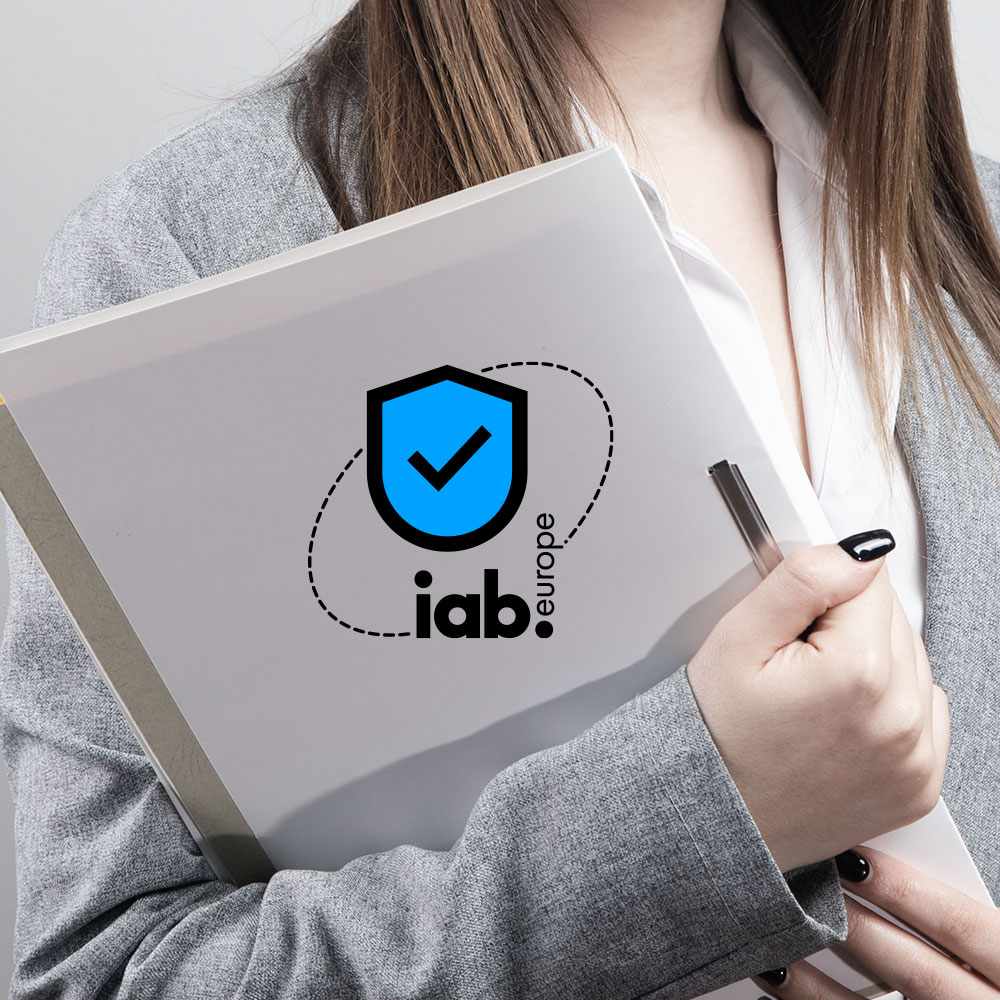In a landscape where businesses can no longer take customer loyalty for granted, personalization plays a vital role. But enabling customers to feel in control of interactions with businesses is critical to get personalization right.
According to a 2021 report by McKinsey & Company, 71 percent of consumers expect companies to deliver personalized interactions. And when their expectations aren’t met, 76 percent of these consumers experience frustration.
To deliver customized messaging, interactions, and measurement that take customer preferences into account, businesses first need to request, collect, and store customer consents and preference information — while providing their consumers with the transparency and control over their personal data that they now expect.
These expectations have brought changes in regulation, like the Digital Markets Act, as well as shifts in consent and data management, and marketing strategies, such as Google’s plans to phase out third-party cookies in Chrome by 2025.
Evolving expectations have also impacted the move away from second- and third-party data — and the types of cookies and other tracking technologies used to obtain it — and instead center data and marketing strategies around customers’ expressed preferences by way of first- and zero-party data.
In short, businesses now need to balance consumer expectations for personalized experiences with data privacy compliance requirements from governments and the influential tech platforms that they rely on. As a result, preference management tools that combine and centralize user preferences are now indispensable, especially when they integrate with the full marketing stack.
In this article, we share insights about preference management tools and our top software picks for 2025. From seamless platform integrations to sophisticated segmentation and targeting capabilities, these tools help privacy-aware businesses build trust with their customers and drive revenue growth.
The top preference management tools for 2025:
| Preference management tool | Key features | Recommended for | G2 rating |
|---|---|---|---|
| Usercentrics | Centralized, multi-access preference dashboard Exportable data Seamless integrations | Medium-to-large businesses | 4.5 |
| TrustArc | Customizable consent prompts and data intake forms Rapid API Deeper personalization capabilities | Large organizations, government, and public sector | 4.2 |
| OneTrust | Centralized preference management Customizable user interface | Large enterprises and multinationals, digital and ecommerce platforms | 4.3 |
| Osano | Real-time preference updates Seamless integration with major platforms Advanced segmentation capabilities | Small to medium-sized businesses | 4.6 |
| Didomi | User-friendly interfaces Cross-platform consistency Global compliance framework | Technology and software companies, healthcare and pharmaceutical organizations | 4.6 |
| PossibleNOW | Centralized preference management Omnichannel capability Do Not Contact compliant | Medium to large organizations | 4.7 |
| Clarip | Omnichannel capability Focus on mobile and social media marketing Customizable user interfaces | Ecommerce platforms, financial services, healthcare organizations | 4.8 |
| Cassie | Recognized by Gartner Customer Service Portal API integration | Healthcare, financial, and educational institutions | N/A |
Preference management platform benefits
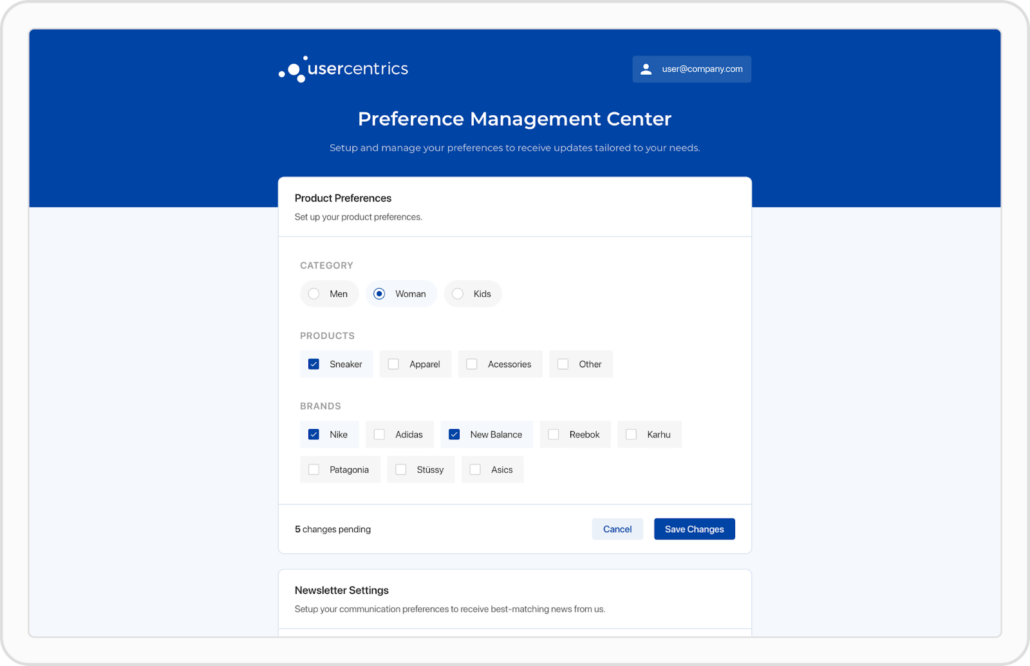 The Usercentrics Preference Manager is fully customizable to your brand identity, and enables you to collect granular user preferences.
The Usercentrics Preference Manager is fully customizable to your brand identity, and enables you to collect granular user preferences.
Preference management platforms stand at the crossroads of customer experience (and satisfaction) and data privacy compliance. They can define and transform how businesses interact with their audiences.
From contributing to privacy compliance operations to delivering personalized customer experiences, here are the top benefits of this powerful class of software.
Improves centralization and data accessibility
Preference management makes it easier to centralize and access your customer’s first- and zero-party data, enabling granular personalization according to user preferences.
Say goodbye to department-specific silos. Your whole organization can access and share data, with built-in security and administrative controls, so users’ stated preferences can be centralized and accessible to various business functions to help ensure privacy compliance and respect for preferred customer interactions across the organization.
This is also valuable for regulatory requirements, centralizing the consent and preference data (and updates to it over time) that’s used across the organization, for a single-source audit trail if data protection authorities inquire.
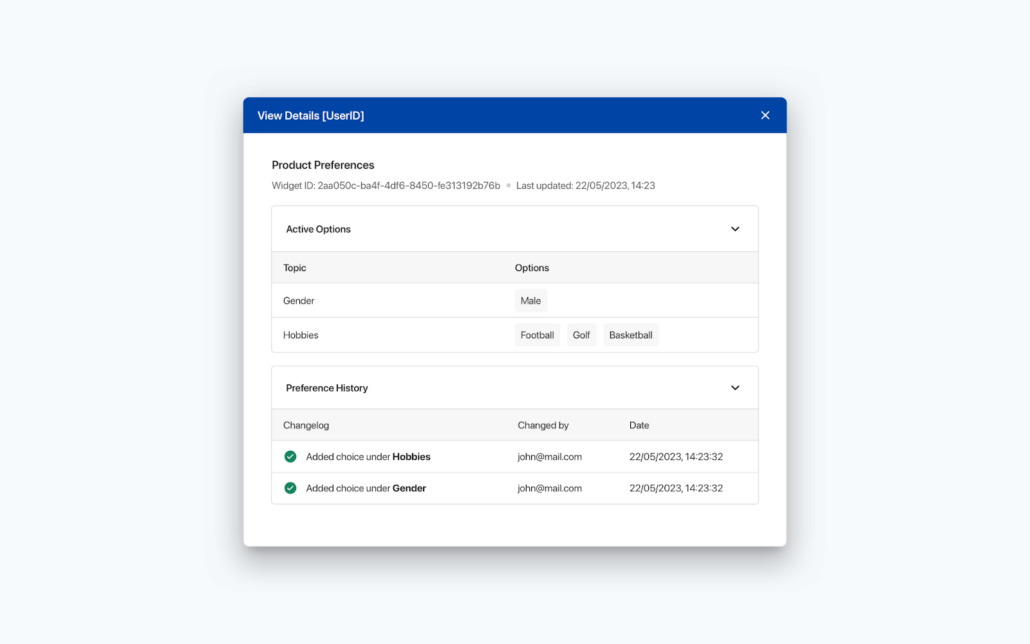 The Usercentrics Preference Manager keeps detailed records of consumer preferences.
The Usercentrics Preference Manager keeps detailed records of consumer preferences.
Provides personalized services
Preference management software helps you get to know your customers more personally, as it takes direct cues about what interests them based on what you ask them about, and the resulting first- and zero-party data they’ve shared with you.
When you’re equipped to provide personalized service, you can cater to the preferences of all customers, not just the larger segments. Do certain segments want to opt out of email? No problem. Do other users just want email updates about special offers and promotions? You can make it happen, increasing engagement and demonstrating your respect for customer consent and preferences.
Read about email marketing privacy policy now
Access scalable storage
The best customer preference management solutions provide secure, scalable storage for the first- and zero-party data you collect, and integrate with other marketing tools and platforms.
They also enable you to perform data housekeeping more systematically. For instance, you can nudge customers to check and update their data, saving you a massive amount of manual work and ensuring greater accuracy. This is also important for data privacy compliance, helping ensure user data is accurate, and only retained as long as necessary.
Notifying customers when their data has been accessed or updated, even if it’s by the customer themself, is also a trust-building signal of your security measures.
Improves customer relations
Consumers are more digitally savvy than ever before. They understand that their relationships with brands are transactional. But they also know how much data companies have about them. They expect it to be used judiciously, and to cater to their preferences in channels, messaging, products, deals, and more.
Consumers who feel understood and respected — and recognize that companies are crafting personalized experiences for them based on what they want — are more engaged and loyal, especially over time.
Enables relevant communications and higher engagement
Customers and brands also have more communication channels than ever before. It’s an opportunity for more consistent engagement and more precise customization for various demographics. It makes determining which channels have the highest ROI easier than ever.
Whether a customer prefers text messages, emails, in-app notifications, or postcards, you can communicate accordingly and automate your efforts at scale.
8 best preference management solutions
1. Usercentrics Preference Manager
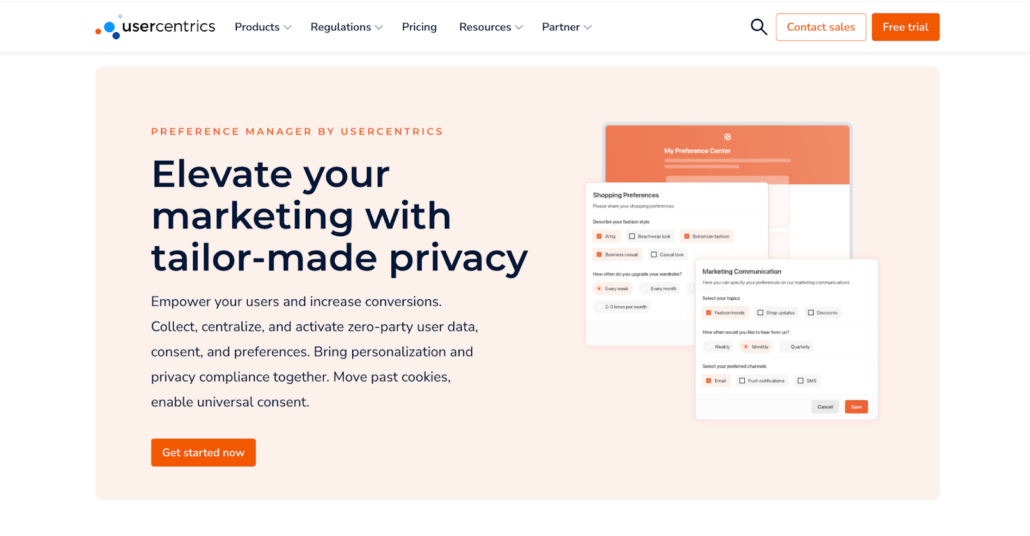
Usercentrics provides consent management and preference management tools that empower businesses to achieve compliance with global data protection regulations like the General Data Protection Regulation (GDPR), California Consumer Privacy Act (CCPA), and more.
Usercentrics platforms provide businesses with the tools to collect, manage, and document user preferences and consent transparently and in a user-friendly way, via the Usercentrics Consent Management Platforms (CMPs) and Preference Manager.
The Preference Manager tool is a central point for collecting, consolidating, and activating zero-party user data, consents, and preferences. This enables you personalize your communication and deliver a brand experience aligned with your users’ stated preferences, while respecting their privacy choices at every touchpoint.
Usercentrics Preference Manager features
- Complete centralization: One-stop, intuitive portal that enables full user control over expressed permission and preference data. You also gain a granular overview of users’ preferences and permissions, which can drive marketing strategy and be signaled throughout your marketing tech stack.
- Fully secure: Ultra-secure thanks to hashing and double opt-in. Includes an automated, time-stamped, and in-depth audit trail.
- Capture and manage granular preferences: Provide full control over marketing preferences and permissions and build stronger, privacy-focused strategies. Includes customizable widgets that enable you to capture granular permissions and preferences to deliver top notch customer experiences.
- Multi-channel collection: Collect first- and zero-party data across your websites and apps. Easily integrates with your marketing tech stack.
- Hassle-free setup: Easy to set up and intuitive to use. Fully customizable to your brand identity and available in multiple languages. Export data for easy integration into existing systems and processes.
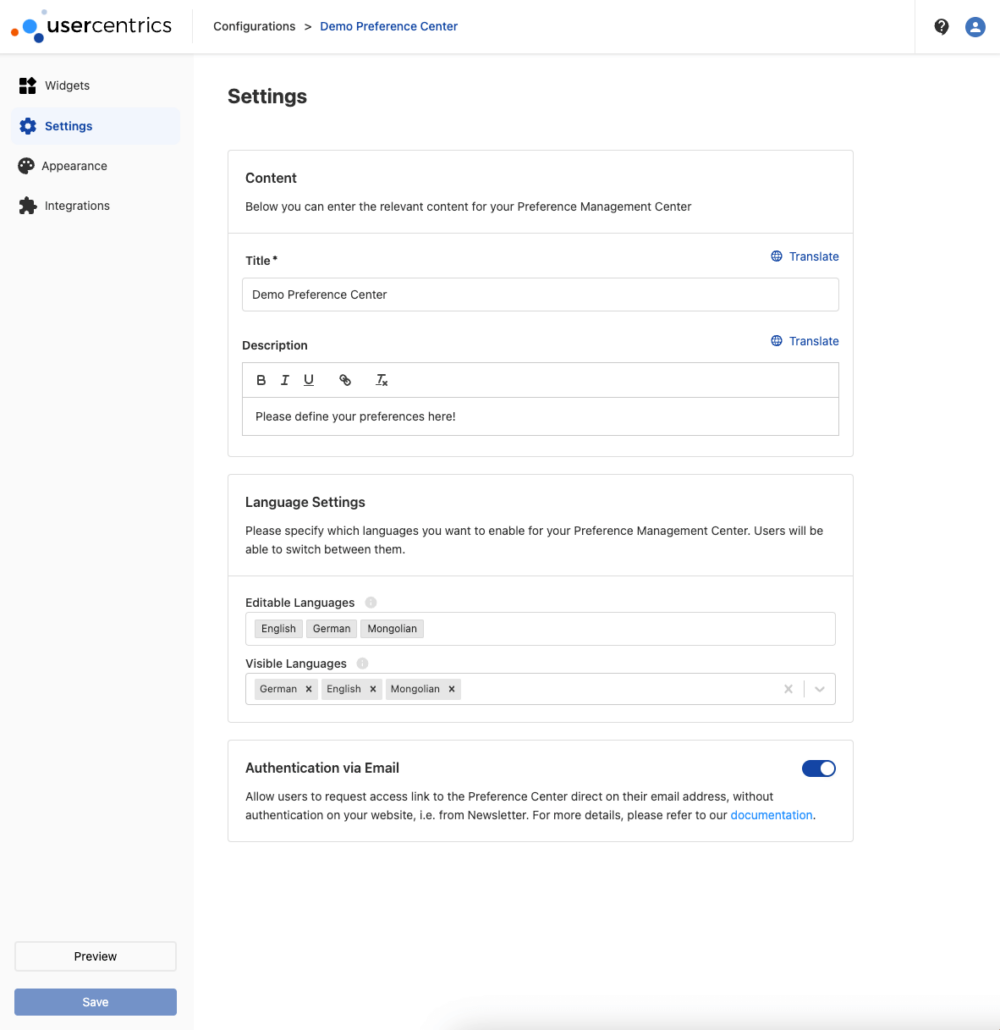
Usercentrics Preference Manager pricing plans
Usercentrics calculates pricing for its preference management tool by the volume of handled data. This is based on the number of users who engage with the tool, not the platform (website/app) sessions. For specific pricing, chat with a Usercentrics expert.
| Pros | Cons |
|---|---|
| Ease of use | Learning curve for advanced features reported by some G2 users |
| Extensive customization | |
| Cross-channel preference collection |
2. OneTrust Universal Consent and Preference Management
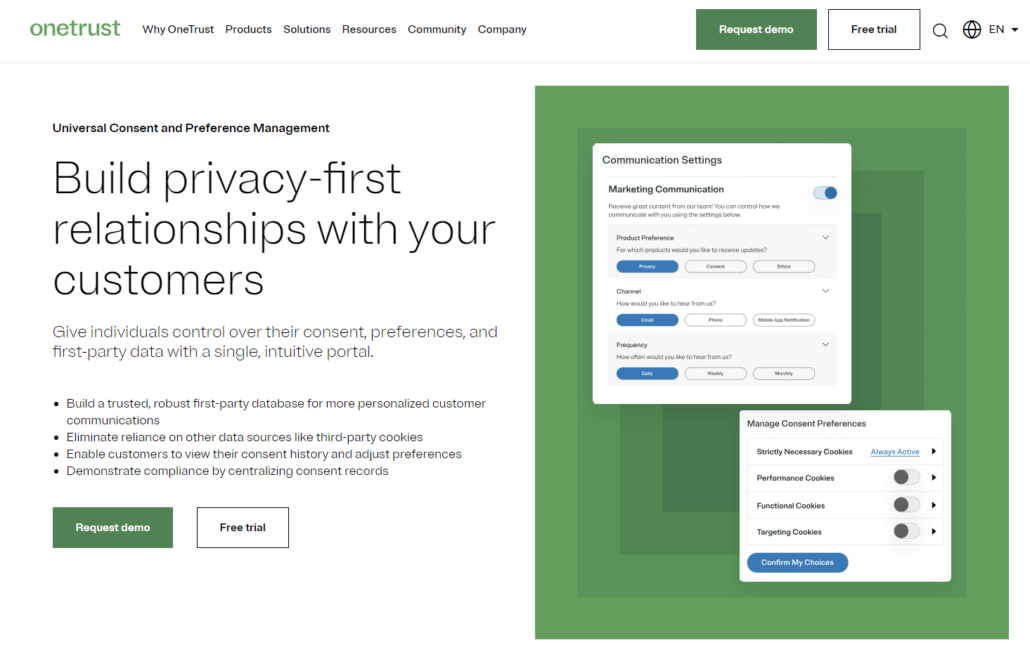 OneTrust Universal Consent and Preference Management
OneTrust Universal Consent and Preference Management
OneTrust provides a privacy management and compliance software tool that helps organizations navigate data privacy regulations, such as the GDPR and CCPA. The company an end-to-end solution for privacy, security, and third-party risk management, a one-stop shop for data governance.
OneTrust offers universal consent and preference management functionality as part of its privacy toolkit. This enables users to control all their consents, preferences, and first-party data from a centralized location. The platform also helps customers roll out personalized communications and customer journeys.
OneTrust preference management features
- Centralized preference management: OneTrust enables centralized control over user preferences across multiple channels and touchpoints.
- Customizable user interface: To give consumers transparency into data collection, customize the user interface for consent and preference collection.
- Build enhanced customer profiles: Embed transparent data collection into the user journey and build richer customer profiles that enhance customer loyalty.
OneTrust preference management pricing plans
OneTrust offers personalized pricing information upon request.
| Pros | Cons |
|---|---|
| Excellent customer support, as per G2 reviews | Steep learning curve, according to G2 users |
| All-inclusive tool that covers consent and preference management | |
| G2 reviews praise the user-friendly interface |
3. Osano Unified Consent & Preference Hub
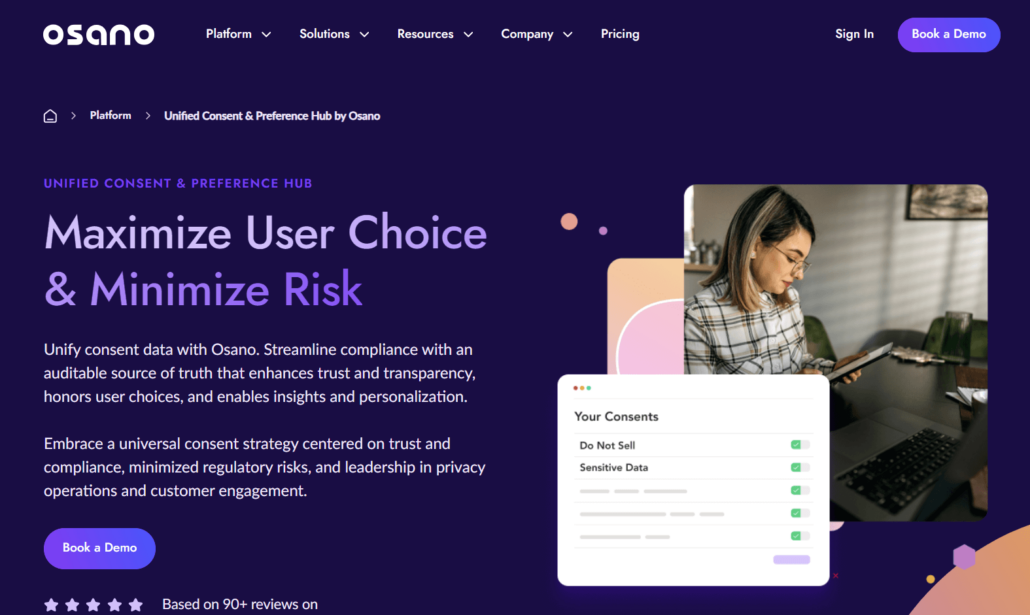
Osano is a data privacy platform that advertises its speciality in consent management and data privacy compliance. In addition to simplifying the process of obtaining, documenting, and managing user consent, the platform touts powerful data discovery and classification features.
Osano’s consent and preference hub also brings together user consents and preference management to enable a privacy-focused approach to personalization that meets consumer expectations and data compliance needs.
Osano Unified Consent & Preference Hub features
- Real-time preference updates: Users can update their preferences at any time, with changes instantly reflected across all platforms.
- Seamless integration with major platforms: Osano boasts easy integration with a wide range of content management systems, email marketing tools, and CRM platforms.
- Advanced segmentation capabilities: Osano enables user segmentation based on their consent and preferences, for more targeted and effective marketing campaigns.
Osano Unified Consent & Preference Hub pricing plans
The Unified Consent & Preference Hub is only available on the following plans:
- Privacy essentials
- Privacy operations & governance
Specific pricing information is only available upon request.
| Pros | Cons |
|---|---|
| G2 users review the tool as easy to use | Some G2 users have noted they would like more customization capabilities |
| Helpful support team, as per G2 reviews | |
| Ranked top by G2 users for easiest setup and fastest implementation in spring 2024 |
4. Clarip Universal Consent & Preferences
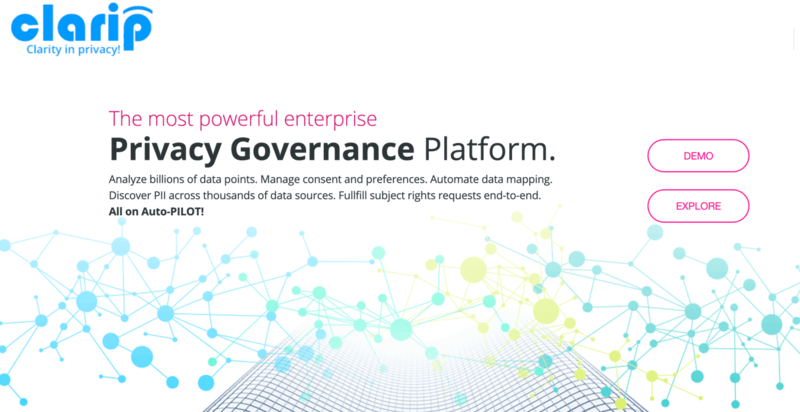
Clarip advertises enabling businesses to collect, manage, and act upon user preferences and consent across multiple channels in real time.
By unifying consent and preference management, plus providing users with direct control over their personal information and how it’s used, Clarip touts that they facilitate compliance with global privacy regulations, while building customer trust.
The company claims that its intuitive interface and robust integration capabilities can help customers tailor marketing efforts to meet audiences’ exact needs and preferences, leading to a more personalized customer experience.
Clarip consent and preference manager features
- Privacy-first customer portals: Clarip offers dedicated portals where customers’ users can directly and granularly manage their preferences and consent settings.
- Customizable user interfaces: The platform’s user interfaces are highly customizable, so companies can tailor the look and feel of their preference management system.
- Smooth integration: Companies can communicate consumer preferences to the rest of their marketing and CRM systems with Clarip API.
Clarip consent and preference manager pricing plans
Specific pricing information is only available upon request.
| Pros | Cons |
|---|---|
| While user reviews are few, some G2 users enjoy the wide range of privacy features | The tool has limited user reviews |
5. Didomi Preference Management
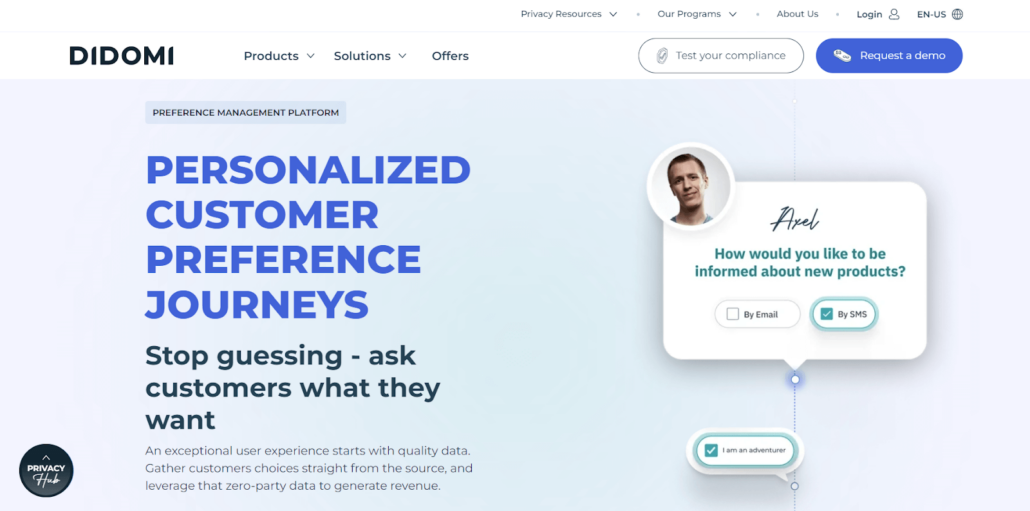
Didomi is a multi-platform provider of privacy solutions. It includes preference management functionality that enables companies to craft tailored experiences that match the needs of their audiences, as well as a consent management platform (CMP) they can use to gather, store, and leverage user consent.
Didomi advertises that together, these features equip companies to build trust, enhance engagement, and better align marketing initiatives with customer expectations while remaining compliant with privacy regulations.
Beyond its technical offerings, Didomi claims to set itself apart via proactive customer support and a wealth of educational resources that will help customers navigate the complexities of consent and preference management.
Didomi Preference Management features
- User-friendly interfaces: Intuitive and customizable preference centers that are designed to be engaging and easy to navigate for end users.
- Cross-platform consistency: Synchronize user preferences across all touchpoints, from mobile apps to web platforms and even in offline environments.
- Global compliance framework: Dynamic framework enables easily adjusting consent and preference management practices to comply with evolving regulations.
Didomi Preference Management pricing plans
Didomi offers three plans. However, Preference Management is only available on its Privacy UX Plus plan. Specific pricing is available on request.
| Pros | Cons |
|---|---|
| Excellent customer service reported by G2 users | A G2 user report of Didomi impacting their site’s performance poorly |
| Easy to use, according to G2 users | |
| Personalized consumer preference pages |
6. TrustArc Consent and Preference Manager
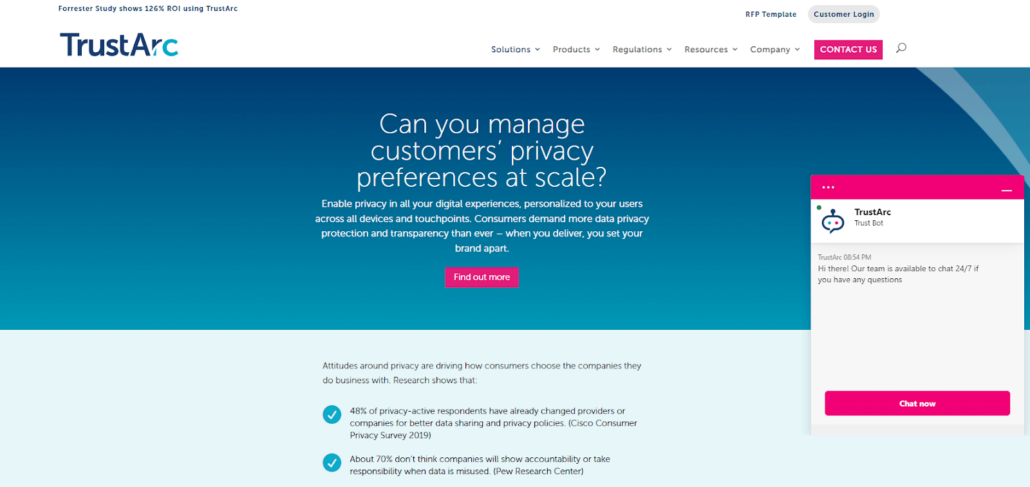
TrustArc‘s stated mission is centered around helping businesses of all sizes manage privacy risk, comply with complex regulations, and build trust with their customers through responsible data practices and granular preference management.
To that end, the platform provides solutions for privacy compliance, data protection risk management, and consent and preference management, enabling privacy throughout the customer journey.
TrustArc Consent and Preference Manager features
- Customization: Personalize consent prompts and data intake forms to provide the best possible customer experience.
- Rapid API: Sync consumer preferences and consent across marketing and vendor systems, in real time.
- Deeper personalization: Track consents against consumer profiles, making improving preference management and providing top-tier personalization easier.
TrustArc Consent and Preference Manager pricing plans
Pricing only available on request.
| Pros | Cons |
|---|---|
| Rapid API | Some G2 users suggest improvements to onboarding and training |
| G2 users enjoy the options for customization | |
| Rich functionality |
7. Cassie Preference Center
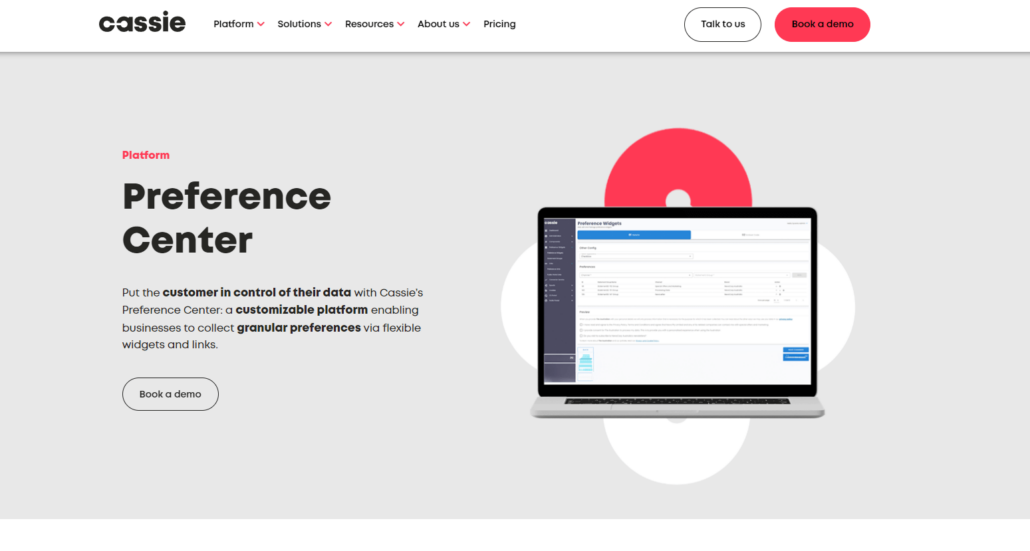
Cassie is a privacy management and consent platform developed by Syrenis. It’s advertised as an all-encompassing tool that covers consent, cookie, and preference management. The platform includes granular consent and preference capabilities.
Cassie’s advanced Preference Management Platform enables businesses to give users more control over their data. The portal is fully brandable and customizable and uses flexible widgets and links to collect granular user preferences to deliver an optimized and personalized customer experience.
Paired with the Customer Service Portal, customers’ teams will be able to ensure timely updates to customer permissions and preferences from a single source of truth.
Cassie Preference Center features
- Preference management: Empower users to manage their preferences across multiple channels and touchpoints from a single portal.
- Customer Service Portal: Quick and easy for support teams to respond to any customer preference requests on a secure customer service portal.
- API integration: Enables integration with other systems and applications via Cassie’s vast selection of APIs and helps to ensure consent and preference data can flow seamlessly across customers’ digital ecosystem in real time.
Cassie Preference Center pricing plans
Cassie offers custom pricing only on request.
| Pros | Cons |
|---|---|
| User verification via two-factor authentication and PII | Limited third-party reviews available |
| Fully brandable UI | |
| Vast API library |
8. PossibleNOW MyPreferences
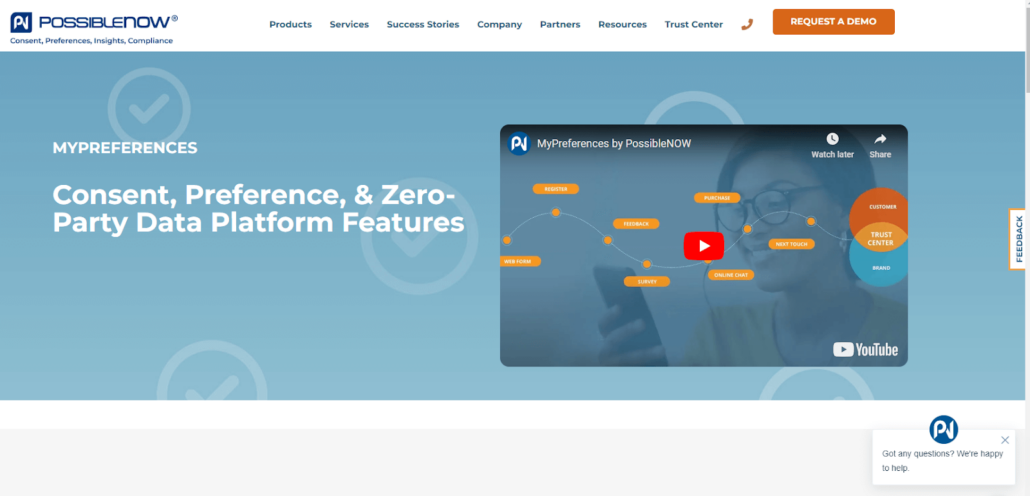
PossibleNOW specializes in preference and consent management solutions, as well as data privacy compliance and customer experience management.
PossibleNOW’s MyPreferences offering is an enterprise preference management platform that enables customers to capture, manage, and leverage customer preferences and consent across multiple channels and touchpoints.
The tool enables businesses to create multilingual and fully customizable experiences based on zero-party data. With its built-in propagation engine, MyPreferences enables customers’ stated preferences to be carried over to all contact methods.
PossibleNOW MyPreferences features
- Centralized preference management: MyPreferences provides a centralized platform for managing all customer preferences and consent, enabling customers to collect granular zero-party data to inform micro-experiences.
- Omnichannel capability: The platform supports preference collection and management across a wide range of channels, including web, email, SMS, call centers, and in-person interactions.
- Do Not Contact compliant: Integrated with a “Do Not Contact” solution to help ensure compliance with various regulations, including TCPA, CAN-SPAM, and CSL.
PossibleNOW MyPreferences pricing plans
PossibleNOW offers custom pricing only on request.
| Pros | Cons |
|---|---|
| Do Not Contact compliant | Some G2 users find the tool to be complex |
| Includes secure, agent-facing portal to manage customer preferences | |
| Suitable for scaling companies |
What is the value of combining a preference management solution with a consent management solution?
Combining preference management and consent management in a single solution offers a number of key benefits. These include:
- Easy integration: Preference and consent management solutions can be easily integrated with companies’ existing tools for websites and apps. They don’t require massive financial or resource investment or the reworking of existing systems.
- Enhances data strategy and marketing operations: With consent and preference management provided by a single platform, end users get a single touchpoint to manage their own data with companies, including consent choices for data privacy, personal contact information, communication preferences, and purchase history.
Companies can also limit the number of vendors they need to engage to achieve their business objectives, access and centralize the data they need for marketing initiatives, and enable their privacy compliance when they do so. - Better customer experience: The two solutions working together and providing data transparency make it easier for end users provide information to get the communications and interactions with companies that they want, when they want them.
These solutions demonstrate respect for end users, helping them to become more comfortable engaging with businesses, and more inclined to provide additional data and complete more purchases. They can also feel confident about their privacy being respected, as brands are transparent about data use.
Integrate preference management and consent management with Usercentrics
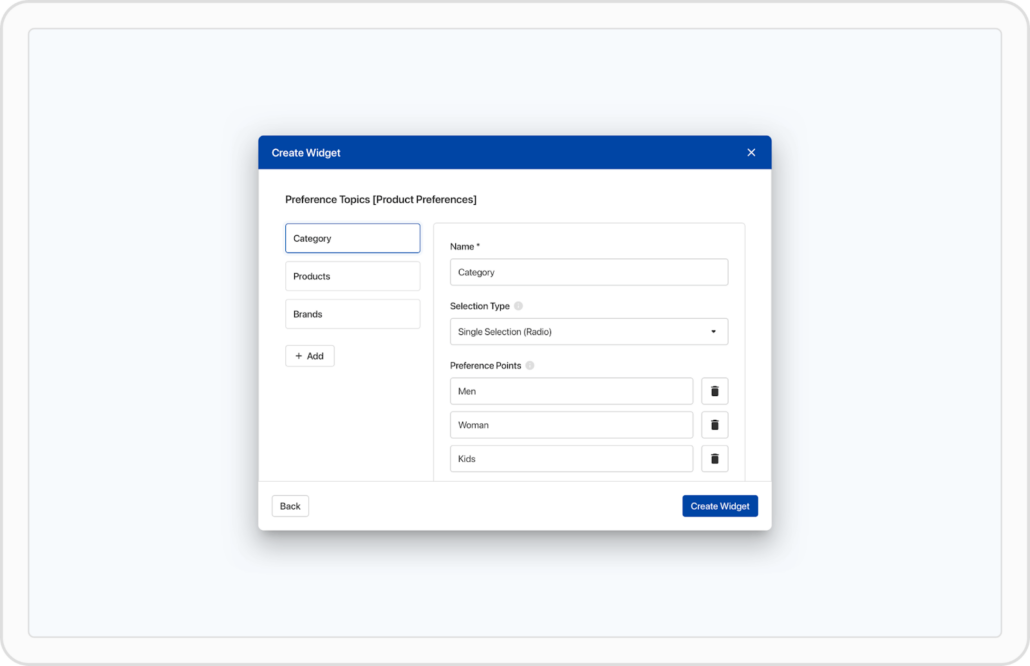
The Usercentrics Preference Manager enables you to create custom widgets to collect granular consumer data.
Preference management platforms help you balance personalization with privacy, enable compliance with data protection laws, and empower your customers to take control of their data. By giving users privacy control, these tools help to build trust and boost user engagement.
Read about email marketing laws now
Usercentrics offers a robust platform for seamlessly integrating consent and preference management. Using Usercentrics CMP and Preference Manager, you can incorporate all the user data into your Preference Management Portal. This empowers you to create a centralized preference management hub, giving users a complete view of and access to and customization ability for their consents and permissions.
With Usercentrics, your business can position itself for ongoing success in a privacy-conscious marketplace. Talk to one of our experts.





